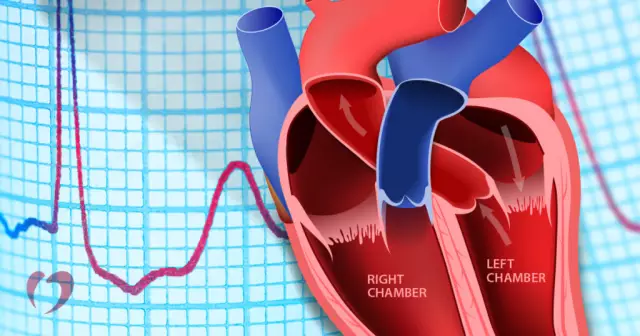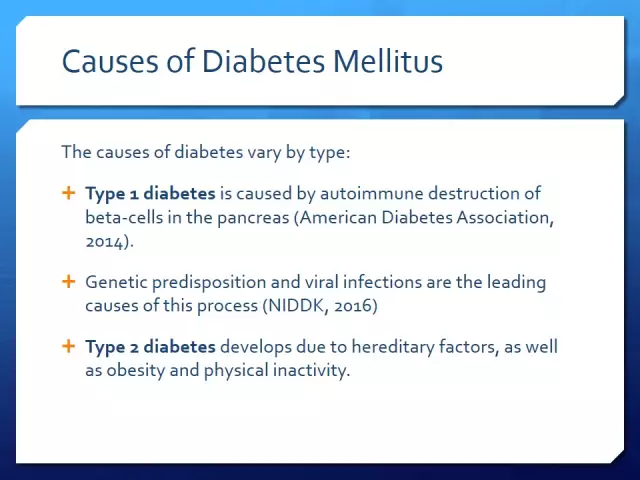- Author Rachel Wainwright [email protected].
- Public 2023-12-15 07:39.
- Last modified 2025-11-02 20:14.
Dystrophy
The content of the article:
- Dystrophy causes and risk factors
- Types of dystrophy
- Dystrophy stages
- Dystrophy symptoms
- Dystrophy in children
- Diagnostics
- Dystrophy treatment
- Potential consequences and complications
- Forecast
- Prevention
Dystrophy is a violation of trophism, i.e. nutrition, tissues and organs. Most often in practice, they are faced with alimentary dystrophy.
Alimentary dystrophy is a disease that develops against a background of severe protein and energy deficiency and manifests itself as a significant loss of body weight (over 20%), brittle nails and hair, dry skin, general weakness, lethargy, drowsiness, increased appetite.
Alimentary dystrophy belongs to a group of social diseases and develops as a result of deliberate or forced starvation. More than half a million people living in developing countries suffer from it. This disease is also registered in quite prosperous countries - here it is caused by long-term adherence to low-calorie diets in an effort to achieve an "ideal" figure.
With prolonged starvation, the body does not receive the necessary plastic substances, which causes metabolic disturbances. As a result, the patient develops anorexia, which is essentially nutritional dystrophy.

Source: bigslide.ru
Dystrophy causes and risk factors
The main cause of dystrophy is prolonged fasting, which leads to insufficient intake of energy and nutrients in the body. Energy deficiency can be of two types:
- absolute - the daily caloric content of the diet does not cover the basic needs of the body, that is, its costs for maintaining life (basal metabolism);
- relative - the intake of energy from food does not cover its consumption.
Fasting can be caused by a variety of reasons, both external (natural disaster, war) and internal (cicatricial narrowing of the esophagus).
Hypothermia and hard physical labor aggravate metabolic disorders in alimentary dystrophy.
Prolonged energy starvation leads to depletion of fat and glycogen reserves in the body, after which interstitial proteins are used up to maintain basic metabolism. Dystrophic processes initially begin in the skin, then spread to the internal organs. Vital organs (brain, heart, kidneys) are the last to suffer from dystrophy.
In advanced cases, not only the catabolic processes change significantly, but also the reserves of minerals and vitamins are depleted, the immune system ceases to function fully. The accession of a secondary infection or increasing cardiovascular insufficiency becomes the cause of death.
Types of dystrophy
Depending on the characteristics of the clinical course, there are two types of dystrophy:
- dry (cachectic) - characterized by an unfavorable course and resistance to therapy;
- edematous - characterized by the presence of edema, ascites, effusion pleurisy and pericarditis.
Dystrophy stages
In the course of alimentary dystrophy, three stages are distinguished.
- Body weight is slightly reduced, working capacity is generally preserved. Patients complain of weakness, chilliness, increased appetite, thirst and frequent urination.
- Significant weight loss and decreased performance are noted. Patients cannot fulfill their professional duties, but the ability to self-care is preserved. The level of protein in the blood is significantly reduced, which leads to the appearance of protein-free edema. Episodes of hypoglycemia occur periodically;
- Patients are severely emaciated, unable to move independently. A hungry coma may develop.
Dystrophy symptoms
The clinical picture of alimentary dystrophy is growing slowly, and for a long time patients do not feel sick. The first signs of the disease usually go unnoticed. These include:
- increased appetite and thirst;
- constant sleepiness;
- decreased performance;
- irritability;
- weakness;
- polyuria.
One of the first specific symptoms of dystrophy is the increased need of patients for salty food, up to eating pure table salt.
With the further progression of alimentary dystrophy, the skin loses its elasticity, becomes dry and flabby, hangs in pronounced folds and resembles a sheet of parchment in its appearance.
The general condition of patients suffers significantly. It becomes difficult to do any physical work. Then signs of dystrophic damage to internal organs appear:
- dyspeptic manifestations (constipation, flatulence, belching);
- decrease in body temperature;
- bradycardia;
- persistent lowering of blood pressure;
- decreased libido;
- cessation of menstrual function;
- erectile disfunction;
- infertility;
- mental disorders.
At the last stage of alimentary dystrophy, all functions of the patient's body begin to fade away. Muscles become thinner and flabby. The subcutaneous fat layer disappears completely. The patient loses the ability to move independently.

Source: medbooking.com
Disorders of mineral metabolism lead to increased fragility of bones, the occurrence of fractures, even under the influence of minimal physical exertion. The processes of hematopoiesis are inhibited, the content of leukocytes, erythrocytes, platelets in the blood decreases. The accumulation of catabolic products in the blood has a negative effect on the central nervous system, which causes persistent mental disorders.
Dystrophy in children
Alimentary dystrophy can develop at any age, but most often affects children under 3 years of age. It is a socially conditioned disease associated with inadequate child care and poor nutrition. In the CIS countries and Europe, alimentary dystrophy is observed in about 2% of children. The incidence rate is significantly higher in African countries, where it reaches 20-27%.
The causes of dystrophy in children can be:
- malabsorption syndrome (with celiac disease, cystic fibrosis);
- malformations of the digestive tract (Hirschsprung's disease, megacolon, pyloric stenosis of the stomach, non-closure of the hard and / or soft palate);
- diseases of the gastrointestinal tract (cholecystitis, pancreatitis, gastritis, gastroenteritis, polyposis of the stomach and intestines, malignant tumors);
- lack of breast milk;
- incorrect calculation of the child's diet;
- defects in child care.
With a mild degree of dystrophy in children, the general condition suffers little. There is a decrease in skin turgor, the subcutaneous fat layer in the anterior abdominal wall becomes thinner.
As the disease progresses, the child becomes lethargic and apathetic, begins to lag behind in psychomotor development. Muscle tone decreases. Body temperature is low. Fatty tissue on the body is thinned and is retained only on the face. At this stage of alimentary dystrophy, children develop concomitant diseases (pyelonephritis, sinusitis, pneumonia, tonsillitis).
With a severe degree of dystrophy, children lose their previously mastered skills. They have increased irritability and drowsiness. Due to the lack of subcutaneous tissue, the skin hangs down in folds, and the face takes on an aging expression.
Violations of the water-electrolyte balance leads to the development of exsicosis, drying of the cornea of the eyes. Dysfunction of the gastrointestinal tract, cardiovascular and respiratory failure are expressed. Body temperature is significantly reduced.

Source: present5.com
Diagnostics
The diagnosis is established according to the medical examination of the patient and indications of prolonged fasting in the anamnesis. To confirm the diagnosis, a laboratory and instrumental examination is carried out, including:
- blood chemistry;
- detailed general blood test;
- Ultrasound, computed and magnetic resonance imaging of the abdominal organs;
- skin biopsy.
Alimentary dystrophy requires differential diagnosis with other pathologies accompanied by general depletion of the body:
- thyrotoxicosis;
- pituitary disorders;
- diabetes;
- tuberculosis;
- neoplastic diseases (primarily intestinal and stomach cancer).
Dystrophy treatment
Patients with alimentary dystrophy require hospitalization in the department of gastroenterology. They are placed in a well-ventilated and warm room, and contact with other patients is limited in order to prevent infection with infectious diseases.
Therapy for any type of dystrophy begins with normalization from the daily regimen and proper nutrition. Patients with stage I of the disease are given food often, but in small portions. At stages II and III of alimentary dystrophy, enteral nutrition is carried out with special nutritional mixtures (enpits) and is combined with parenteral nutrition (intravenous administration of glucose, fat emulsions, protein hydrolysates, vitamins). As the patient's condition improves, he is gradually transferred to normal food.
The diet of patients with alimentary dystrophy should contain a sufficient amount of protein (at least 2 g / kg / day), most of which should be represented by animal protein.
At stage III of alimentary dystrophy, treatment, in addition to diet, includes transfusion of blood products (albumin, fresh frozen plasma, erythrocyte mass), infusion therapy aimed at correcting water-electrolyte disorders and acid-base balance.
With the development of infectious complications, the patient is prescribed antibiotics, taking into account the antibiogram data.
According to indications, probiotics and prebiotics, immunomodulators, enzyme preparations can be used.
The development of a hungry coma is the basis for emergency hospitalization in the intensive care unit. The patient is injected intravenously with hypertonic glucose solutions, vitamins, anticonvulsants.
After the end of the course of treatment, patients with alimentary dystrophy need a long course of physical and mental rehabilitation, which should last at least six months.
Potential consequences and complications
One of the hardest complications of alimentary dystrophy is a hungry coma. A significant drop in serum glucose concentration leads to its development, as a result of which the brain experiences a pronounced energy deficit. The symptoms of this condition are:
- sudden loss of consciousness;
- dilated pupils;
- pale and cold skin;
- significant decrease in body temperature;
- decreased muscle tone;
- threadlike pulse;
- breathing is shallow, arrhythmic, rare.
If a patient with a hungry coma is not urgently provided with medical assistance, then against the background of increasing cardiovascular and respiratory failure, a fatal outcome occurs.
Alimentary dystrophy is often complicated by infectious diseases (pneumonia, tuberculosis, intestinal infections, sepsis), as well as pulmonary embolism.
Forecast
Without treatment, dystrophy within 3-5 years leads to the death of the patient. With timely started therapy of the I-II degree of the disease, it ends with recovery, but the recovery period takes several years. Alimentary dystrophy of the last stages usually ends in death, even if the patient is provided with full medical care.
Prevention
Prevention of the development of alimentary dystrophy is based on the promotion among the population of the norms of a healthy lifestyle and rational nutrition, refusal of low-calorie diets that do not cover the body's energy costs.
YouTube video related to the article:

Elena Minkina Doctor anesthesiologist-resuscitator About the author
Education: graduated from the Tashkent State Medical Institute, specializing in general medicine in 1991. Repeatedly passed refresher courses.
Work experience: anesthesiologist-resuscitator of the city maternity complex, resuscitator of the hemodialysis department.
The information is generalized and provided for informational purposes only. At the first sign of illness, see your doctor. Self-medication is hazardous to health!






